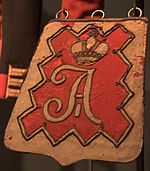Saber pocket
The saber pouch as a flat bag or pouch belonged (and belongs) to the equipment of the light cavalry and was mainly worn in connection with the saber hanger or on the belt.
origin
The origin of the saber pouch is very likely in Hungary , where it was used by mounted men in the form of a flat leather pouch and was known as tarsoly . Early examples are known as grave goods of so-called Magyar mounted warriors from the 10th century, from the historical epoch of Hungary before the Magyars .
In addition to a stable basic design, more valuable specimens were often rich, for example with silver plating, designed and lavishly decorated and contained equipment for preparing fire and other important utensils.
Military use
In the early 18th century, the use of light cavalry in general and the hussars in particular was popularized by all European powers, including in German-speaking armed forces . In this context, the tarsoly , which was a common part of clothing and equipment for Hungarian hussars, also spread. If cavalry units were under German command, tarsoly was soon changed to saber pocket and the core was also adopted in other languages. For example, the terms sabretache found their way into Anglophone and Francophone armed forces. In a slightly different way, the name was szabletash in Poland and taschka (ru: ташка ) in Russia . Regardless of the slightly different semantics , the saber pocket was widely used as a safe and simple transport container that went well with the tight-fitting uniform of mounted soldiers. In times of war, the saber pocket was used as a transport container for messages, orders, dispatches, courier items, etc., whereby light cavalry was primarily used for this. The wide front flap of the saber pocket was adorned with elaborate embroidery and decorations and also often contained princely / imperial monograms or initials or regimental insignia. Until the 19th century the saber pocket found widespread use in all types of cavalry up to the lancers .
Currently, saber bags are popular militaria collectibles.
gallery
Prussian Hussar around 1763, the saber pocket with the monogram Friedrich II.
Saber pouch with monogram Nicholas II.
Saber pocket of the Napoleonic general Jean-Jacques Desvaux de Saint-Maurice
Saber bag of the Imperial Russian Life Guard Hussar Regiment , 1802–1825
Bengali lancers with saber pockets in the service of the British Colonial Army , India 1867
Danish Guard Husar 2012, the saber pocket shows the monogram of Margrethe II.
Remarks
- ↑ Tarsoly Bearer's Homepage
- ^ András Róna-Tas: Hungarians and Europe in the Early Middle Ages: An Introduction to Early Hungarian History . Central European University Press, Budapest 1999, ISBN 963-9116-48-3 , pp. 136 (English, 566 p., Limited preview in Google book search).
- ↑ Canadian Military History Gateway: Royal Staff Corps officer's sabretache, circa 1820 ( Memento of March 23, 2014 in the Internet Archive )
- ↑ Sabretaches by Lt. Colonel JBR Nicholson
- ↑ James Alexander Mackay: An encyclopedia of small antiques . Ward Lock, London 1975, ISBN 0-7063-5015-4 , pp. 164 (English, 320 pp., Limited preview in Google Book Search).








